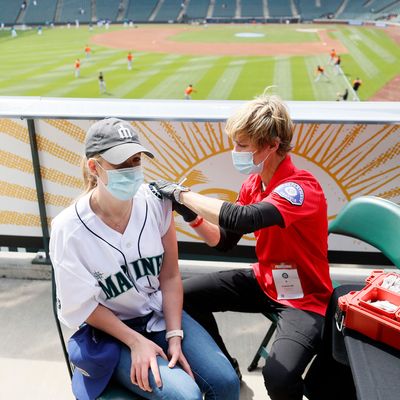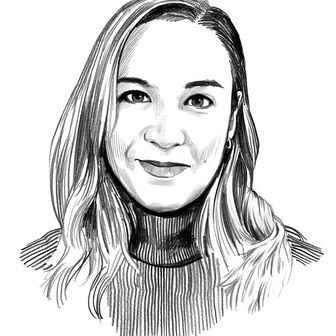
Justin Sanetra is “waiting to see how things develop” before he gets a COVID-19 vaccine. His reasons are varied and include his allergies, which are many. He worries about the side effects, too. “When I got the flu shot before, it kind of wrecked me,” he said, adding that most people he knows got sick after their shots. He wonders if it’s even necessary: “I had to deal with people that got COVID and got pretty sick and I was around them a lot and I didn’t end up getting it, so I don’t know if it’s something that I might need.” This is where an epidemiologist may want to interject: The virus has skipped Sanetra for now, but his good fortune might not last forever. There’s only one way he can protect himself from serious illness or even death, and it’s the vaccine he’s reluctant to get.
Persuading people like Sanetra to get vaccinated is an urgent dilemma for epidemiologists, physicians, and public-health officials alike. If the holdouts don’t change their minds, the country may not reach herd immunity. Most of the hesitant say they aren’t necessarily anti-science or even anti-vaccine; instead, they are in a “wait and see” category estimated to comprise around 12 percent of the population, according to the Kaiser Family Foundation. Several told Intelligencer they simply had questions about how the vaccine came to be in the first place, fearing the shots were approved in a politically motivated rush. (Some asked to be referred to only by their first names.)
For many people, the facts about the vaccines — they’re safe and effective, their side effects rare and not life threatening — have been enough to persuade them to get vaccinated. Around half of all American adults are now fully vaccinated. And not all holdouts are “hesitant” in the traditional sense: Many in the working class say they don’t have the time either to get the shot or to recover from possible side effects. According to an April KFF poll reported by the Washington Post, around half of adults who have not been vaccinated say they’re worried about missing work because of side effects. Rates were particularly high among Black and Hispanic respondents, who are less likely to work jobs that lack paid leave. The problem here is pervasive inequality, not misinformation about vaccines.
Those in the wait-and-see category aren’t wrong to feel some anxiety, said Dr. Paul Offit, who directs the Vaccine Education Center at the Children’s Hospital of Philadelphia. “I think that anybody who came to me and said, ‘Look, I’m nervous about this. I understand it was tested in thousands of people, but that’s not millions of people, and I’m not helpless here. I can wear a mask, I can physically distance, I want to wait,’ I think that’s fair. That kind of skepticism is reasonable,” he said.
Emily Johnson, who lives with medical conditions that include Ehlers-Danlos syndrome and mitochondrial disease, said she worried about potential vaccine reactions. “Ultimately, I decided to get vaccinated after discussing it with my allergist-immunologist, my cardiologist, my home health nurse, and others,” she said. Her family didn’t adhere to masking or social-distancing rules, and since medical providers regularly entered her home to provide care, she couldn’t be certain that her own caution would be enough to protect her from such a dangerous virus. “My health team and I decided that even if I had a severe immune response to the vaccine, it was better to try to get some antibody response and suffer than to get COVID from providers and family,” she explained. Though she did suffer side effects, she said she feels “lucky,” as she knows other people with chronic illnesses “needed longer to recover their baselines.”
Offit said there’s a difference between reluctant people such as Emily and outright cynics, who “don’t believe the data that they’re being shown. They think that it’s a conspiracy among groups like the medical establishment, the pharmaceutical industry, the government. They’re denialists and conspiracy theorists. So there is no convincing them.”
But time and data can ease the skeptics’ misgivings. Rachel had followed the coronavirus vaccines’ development from the beginning, listening to updates every day on NPR. Everything seemed so fast. There was “also the fact that the vaccine development started during the Trump era after he fired all these scientists,” she said. The government simply didn’t appear trustworthy. Getting a fast-tracked vaccine, she added, “just didn’t jive with my own personal philosophy.”
Despite her concerns, Rachel decided to get vaccinated. “We got invited to a few weddings over the summer, and there’s going to be people coming from all over the country that I don’t know. And they are outside of my little bubble, from different states that have different regulations.” She still has reservations about her decision, but the vaccine promises protection, and that’s what she wants.
Glenn, like Rachel, worried that the vaccine information made available under Trump “wasn’t quite reliable,” though he eventually got his shot. “If someone was able to show to me that” the Trump White House “hadn’t compromised the CDC’s ability to look over the vaccine, I would have felt comfortable getting it sooner.” Though Trump is no longer in office, Glenn wants to see some accountability from the CDC, which he felt was harmed by the impulse to reopen the economy at all costs under Trump.
Marie-Françoise said there’s likely nothing anyone could have said to persuade her to get the shot before she did. What changed her mind was the passage of time and the opportunities getting vaccinated granted her. “I have relatives out of this country, and I want to go visit them,” she said. She’s an actor and writer, and though she underwent frequent COVID testing, she needed more certainty to pay her bills. “I wanted to give myself the best chance possible for work,” she said. “I do know some people who lost work because they tested positive or they actually had it and didn’t know it. And I made the decision to do it for that reason, really. It just made sense for me.”
With time, the percentage of Americans in the “wait and see” category has declined, falling by three points from April to May. Dr. Florencia Greer Polite, chief of the division of general obstetrics and gynecology at the University of Pennsylvania Perelman School of Medicine, said that she, too, initially felt hesitant about getting the vaccine. She “did my own due diligence,” she explained, and learned that the technology used to make the vaccine had in fact been around for years. “That was a game changer for me,” she said. She decided to get the vaccine on December 16, as soon as it was available to her. Then she launched Operation CAVEAT to address the “40 percent difference in the [vaccine] uptake between Black and white health-care workers” at her hospital.
Besides the simple process of waiting for people to become more comfortable with getting vaccinated, the task of addressing vaccine hesitancy may require more trustworthy public institutions. “The first thing I think we have to do is actually acknowledge that we’re a fallible institution,” Polite said of the medical community. Hospitals, she added, know their vaccination rates, even if they’re reluctant to publicize them. “But in order to address a problem, you have to acknowledge that there is a problem,” she explained. “And I think that’s really how we build institutions, by acknowledging that these institutions are inherently set up to be racist.”
To help close the vaccine disparity between white and Black and brown health-care people, Polite said, “we have to be affirmative in being anti-racist. We really do have to think about everything from recruitment, hiring and firing, from a patient-care perspective, every experience that someone has. How is this experience equitable or not equitable? And that requires us to do not just some soul searching, but it requires us to tear down some of the things that are, quite frankly, inherent to who we are.”
Glenn believes the CDC has to grapple with its earlier pandemic failures and stress how to safely reopen for the public at large. “Things like that, I think, would go a long way toward showing that they are not just looking out for the one percent or whatever, but they’re looking out for the people who are actually affected by their decisions and who go along with what they say because they are an institution to be trusted,” he said.
The CDC, Marie-Françoise echoed, needs “somebody up there who knows how to tell a story. There needs to be a way to explain what needs to happen without alarming people, but telling people the truth in a way that’s understandable,” she added. “And that’s a tall order, I know it is: to simplify something that’s not simple. That’s probably way more complicated than most people can comprehend in their daily lives. But there just needs to be truthful ways of saying hard things.”
Sanetra said he wants to trust institutions like doctors and the CDC. “But at the same time, I always get worried that those kinds of organizations are perverted by politics and capitalism,” he said, pointing to frustrating interactions he has had with the health-care system, such as doctors who treated him as though he were out for painkillers. He’s skeptical of the health-care system at large. “And then I see my friends from Canada talking about how they kind of just go to the doctor without any worries of spending money or being in debt or something,” he reflected. “Seems like we’re pretty far behind for a first-world country.”
Ultimately, Sanetra said what may convince him is not data but the need to pay his bills. A musician, he’s waiting to see what venues expect of performers. “I would probably get the vaccine if it was required to play on tour and stuff again,” he said. “I wouldn’t mess around with that and be anti-vaccine, if that’s going to be like the new thing that you have to do.”






























